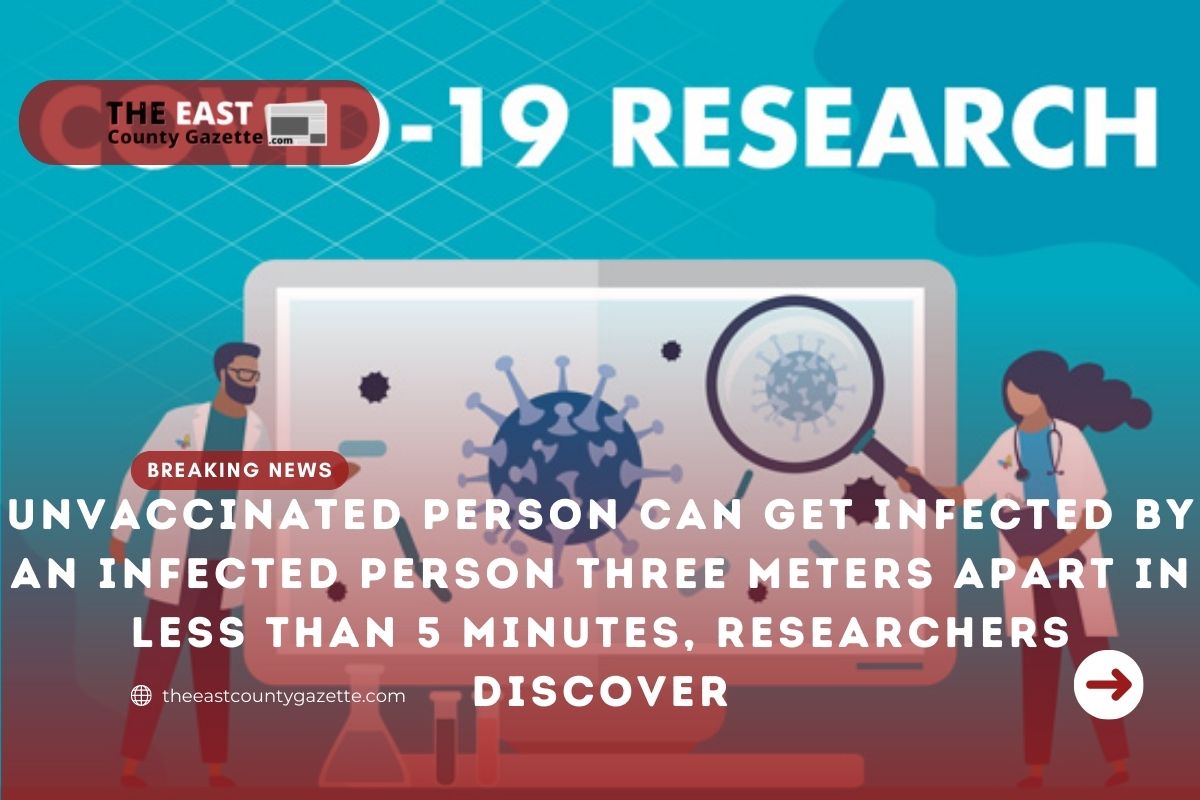Unvaccinated Person Can Get Infected by an Infected Person 3 Meters Apart in Less Than 5 Minutes, Researchers Discover
A distance of three meters is insufficient for protection. Unvaccinated persons standing less than five minutes away from someone with COVID-19 are almost certain to become infected within less than five minutes. Unfortunately, this is a piece of bad news.
If they’re wearing FFP2 masks or medical masks that fit well, the risk is greatly reduced. According to a study conducted by the Max Planck Institute for Dynamics and Self-Organisation in Göttingen, masks may offer some protection depending upon the conditions under which they are worn.
Scientists used a unique approach to assess the maximum risk of infection based on a number of contexts and also considered a number of factors that have not been taken into account in earlier studies. The researchers were surprised by the high chance of infection with the Coronavirus in Göttingen.
“We would not have thought that at a distance of several meters it would take so little time for the infectious dose to be absorbed from the breath of a virus carrier,” Max Planck Institute Director, Eberhard Bodenschatz explained.
The infective particles are diluted by the breathing air spreading conically in the air at such a distance. The particular large particles in the air are also quite virus-rich, but they fall to the ground within a short distance from the air.
“In our study, we found that the risk of infection without wearing masks is enormously high after only a few minutes, even at a distance of three meters, if the infected persons have the high viral load of the Delta variant of the SARS-CoV-2 virus,” Bodenschatz pointed out. Meetings of this nature are inevitable at schools, restaurants, clubs, and even outdoors.
Read More: Jay Jay Phillips (America’s Got Talent Star) Dead at the age of 30 After Contracting COVID-19!
Fitted FFP2 masks Reduce the Infection Risk to about One per Thousand Range
While infection risks are high without mouth-nose protection, medical or FFP2 masks are effective at preventing infection. Study findings confirm the efficacy of FFP2 and KN95 masks at preventing infectious particles from entering the airway. In response to both infected and non-infected persons wearing well-fitting FFP2 masks, the maximum risk of infection has been reduced to one per thousand within 20 minutes.
Infections are likely to increase to about four percent if their masks do not fit correctly. In the presence of two individuals wearing well-fitting medical masks, the virus can most likely spread within 20 minutes with a maximum of 10% probability.
Furthermore, the results confirm an intuitive assumption that for effective infection protection, a mask should be fitted tightly to the face of the infected individual and should have an adequate filtering effect.
Based on the infection probability calculations, the Max Planck team determined the upper limit of risk for each case.
“In daily life, the actual probability of infection is certainly 10 to 100 times smaller,” Bodenschatz stated.
“This is because the air that flows out of the mask at the edges is diluted, so you don’t get all the unfiltered breathing air. But we assumed this because we can’t measure for all situations how much breathing air from one mask wearer reaches another person and because we wanted to calculate the risk as conservatively as possible,” Bodenschatz continued.
“Under these conditions, if even the largest theoretical risk is small, then you’re on the very safe side under real conditions.”
“For such a situation, we can determine the viral dose inhaled by an unprotected person with fewer assumptions,” Research group leader at the Max Planck Institute for Dynamics and Self-Organization, Gholamhossein Bagheri commented.
Several factors that had not been taken into account in comparable studies were considered by the Göttingen team when calculating the risk of infection. As an example, research was performed to investigate how a poor fit of the mask can weaken the mask’s protective capabilities, and how this can be avoided.
“The materials of FFP2 or KN95 masks, but also of some medical masks, filter extremely effectively,” Bagheri explained.
“The risk of infection is then dominated by the air coming out and going in at the edges of the mask.” When a mask isn’t on close to the face, it increases this risk.
Researchers Bagheri and Bodenschatz performed elaborate experiments to measure the volume and size of particles that flow through the edges of masks of different fits.
Read More: Social Security Update: When the First COLA Checks Will Come in January 2022! Check Here!
“A mask can be excellently adapted to the shape of the face if you bend its metal strap into a rounded W before putting it on,” Eberhard Bodenschatz said.”Then the infectious aerosol particles no longer get past the mask, and glasses no longer fog up either.”As well as considering droplets that spread when people breathe or speak, the team also examined how they become lighter as they dry in the air.
In addition to remaining in the air longer, these droplets also contain greater virus concentrations as they are released as equal-sized droplets. When inhaled, the particles are hydroscopic, taking up water from the air again and then growing like a drop in a cloud. This allows them to settle more readily in the lungs.
The researchers at Max Planck in Göttingen found that FFP2 masks with a tight fit provided 75 times better protection than surgical masks with a good fit. In addition, the way in which a mask is worn is very important. The risk of infection with a medical mask is lesser than a person without any protection on the mouth and nose.
“That’s why it’s so important for people to wear a mask during the pandemic,” said Gholamhossein Bagheri
“Our results show once again that mask-wearing in schools and also, in general, is a very good idea,” Eberhard Bodenschatz added.

